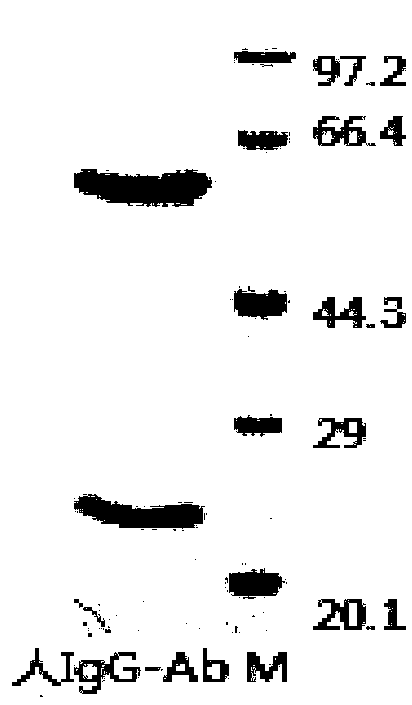Anti-human IgG monoclonal antibody, hybridoma cell line and application thereof
A hybridoma cell line, monoclonal antibody technology, applied in anti-viral immunoglobulin, biochemical equipment and methods, instruments and other directions, can solve the problems of reducing reliability, rising costs, etc. Effects of relaxed storage and handling conditions
- Summary
- Abstract
- Description
- Claims
- Application Information
AI Technical Summary
Problems solved by technology
Method used
Image
Examples
Embodiment 1
[0061] The immunization of embodiment 1 mice
[0062] Human blood-derived IgG antigen (Sichuan Mike Bio-New Material Technology Co., Ltd., batch number 051519) was diluted to 3.0 mg / ml with normal saline, and mixed with an equal volume of Freund's complete adjuvant (Sigma Company, product number SLBF-9338V) (50 μg / ml). BALB / c mice), emulsified into an oily emulsion with a 1ml syringe, until the oily emulsion dripped into the water does not disperse and then stop the emulsification, the emulsion is subcutaneously administered to the BALB / c mice with a dose of 100 μl / axillary limbs ( Chengdu Dashuo Experimental Animal Center, 5-week-old females, 4) Immunization was enhanced 7 days after the first immunization, and human IgG (Sichuan Mike Bio-New Material Technology Co., Ltd., batch number 051519) and Freund's incomplete adjuvant (Sigma Company) were taken to enhance immunity. , Cat. No. SLBM9367V) equal volume mixed (25μg / mouse BALB / c) and then emulsified, the immunization dose ...
Embodiment 2
[0065] The preparation of embodiment 2 hybridoma cell lines
[0066] 2-1 Preparation of feeder cells
[0067] Peritoneal macrophages of normal 12-week-old BALB / c mice were used as feeder cells. One day before the fusion, BALB / c was sacrificed by taking blood from the eyes and pulling the neck, soaking in 0.1% bromogeramine for 1 minute, then soaking in 75% alcohol for 1 minute, lifting the abdominal skin from the hind abdomen with sterile scissors in an ultra-clean bench to expose the peritoneum . Wipe the peritoneum with an alcohol swab to disinfect. Inject 2ml of RPMI1640 culture solution into the abdominal cavity with a syringe, taking care to avoid penetrating into the intestine. Fix the syringe with the right hand so that the needle remains in the abdominal cavity, and gently massage the abdomen with the alcohol cotton ball in the left hand for 1 minute, and then suck out the injected culture solution. Centrifuge at 1000r / min for 5-10 minutes, discard the supernatant....
Embodiment 3
[0080] The preparation of embodiment 3 monoclonal antibody
[0081] Select healthy BALB / c mice of 12-14 weeks, inject 0.5ml liquid paraffin (Tianjin Kemiou) into each mouse intraperitoneally, and inject 1.8×10 6 a hybridoma cell. Ascites can be produced 7-10 days after cell inoculation. Observe the occurrence of ascites in mice every day. If the abdomen is obviously enlarged and the skin feels tense when touched with hands, the mice can be killed by pulling the neck, and the ascites can be sucked into the test tube with a dropper. One mouse can obtain 1-5ml ascites. The collected ascites was centrifuged to obtain the supernatant, and a small sample was taken and stored in a -20°C refrigerator. The ascitic fluid was saturated and precipitated with ammonium sulfate, and then purified with a protein A affinity chromatography column, and the purity of the antibody (denoted as human IgG-Ab) detected by SDS-PAGE was greater than 90%.
PUM
 Login to View More
Login to View More Abstract
Description
Claims
Application Information
 Login to View More
Login to View More - R&D Engineer
- R&D Manager
- IP Professional
- Industry Leading Data Capabilities
- Powerful AI technology
- Patent DNA Extraction
Browse by: Latest US Patents, China's latest patents, Technical Efficacy Thesaurus, Application Domain, Technology Topic, Popular Technical Reports.
© 2024 PatSnap. All rights reserved.Legal|Privacy policy|Modern Slavery Act Transparency Statement|Sitemap|About US| Contact US: help@patsnap.com










